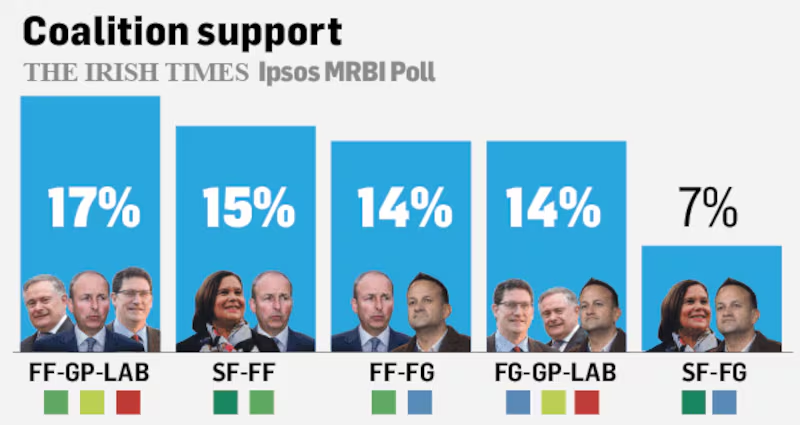Voters are divided on the choice of who should form the next government, according to today's Irish Times/Ipsos MRBI opinion poll, though options involving Fianna Fáil receive the most support.
Offered a series of potential coalition arrangements for the next government, the most popular option was Fianna Fáil, Labour and the Green Party, which was the first choice of 17 per cent of voters.
A further 15 per cent chose a Fianna Fáil-Sinn Féin coalition, while 14 per cent said that their favoured option was a Fianna Fáil-Fine Gael coalition. Though both of these options have been rejected by the Fianna Fáil leader Micheál Martin, an inconclusive election outcome is likely to result in pressure on Martin, including from within his own party, to reconsider. Martin has been adamant that neither is on the cards.

While Fianna Fáil voters have a strong preference for a coalition with Labour and the Greens (43 per cent), they also have a clear preference for Fine Gael ahead of Sinn Féin – with 25 per cent nominating coalition with Leo Varadkar as their first choice, to 16 per cent who favour Sinn Féin.
Among all voters, Fine Gael, Labour and the Green Party garnered 14 per cent support with a Fine Gael-Fianna Fáil combination attracting the same level of support. A Fine Gael-Sinn Féin coalition was favoured by just 7 per cent.
Fianna Fáil and Fine Gael were included in all the options presented to voters as these have been the only two parties in the campaign offering to lead the next government.
Almost a quarter of voters – 23 per cent – did not favour any of the options offered.
When the aggregate of the numbers is looked at, Fianna Fáil emerges on top, with 46 per cent of voters expressing a preference for an option which includes that party. Fine Gael followed with 35 per cent of voters including that party, while coalitions including Sinn Féin attract the support of 22 per cent of voters. Among Sinn Féin voters, a coalition with Fianna Fáil is the most popular outcome, with 43 per cent of the party’s voters favouring a coalition with that party.
Negative rating
Voters were also asked who they did not want to see in government. Sinn Féin attracted the highest negative rating, with 36 per cent of voters saying they did not want to see the party in government. Among Fianna Fáil and Fine Gael voters, however, the figures were considerably higher – 52 per cent and 58 per cent respectively – indicating the difficulty that the leader of either party might find in selling a coalition with Sinn Féin to their own base.
But Fine Gael was not far behind Sinn Féin – almost a third of all voters (32 per cent) do not want to see the party in government after the next election. Under a quarter of voters (23 per cent) do not want to see Fianna Fáil in government.
The party support numbers in the poll suggest that the formation of government could be a difficult and long-drawn out process, with no obvious coalition available. For Fianna Fáil to have the numbers with its favoured option – Labour and the Greens – all three parties would have to do better than they do in this poll.
For Fianna Fáil to make such a government a reality, it would have to reach into the mid-to-high 50s in Dáil seat numbers. To do that it will need to get the mid-to-high 20s in percentage terms. That is, of course, possible. But Fianna Fáil will have to do considerably better than the 23 per cent at which it registers today. Failing that, the formation of the next government will be anything but straightforward.






